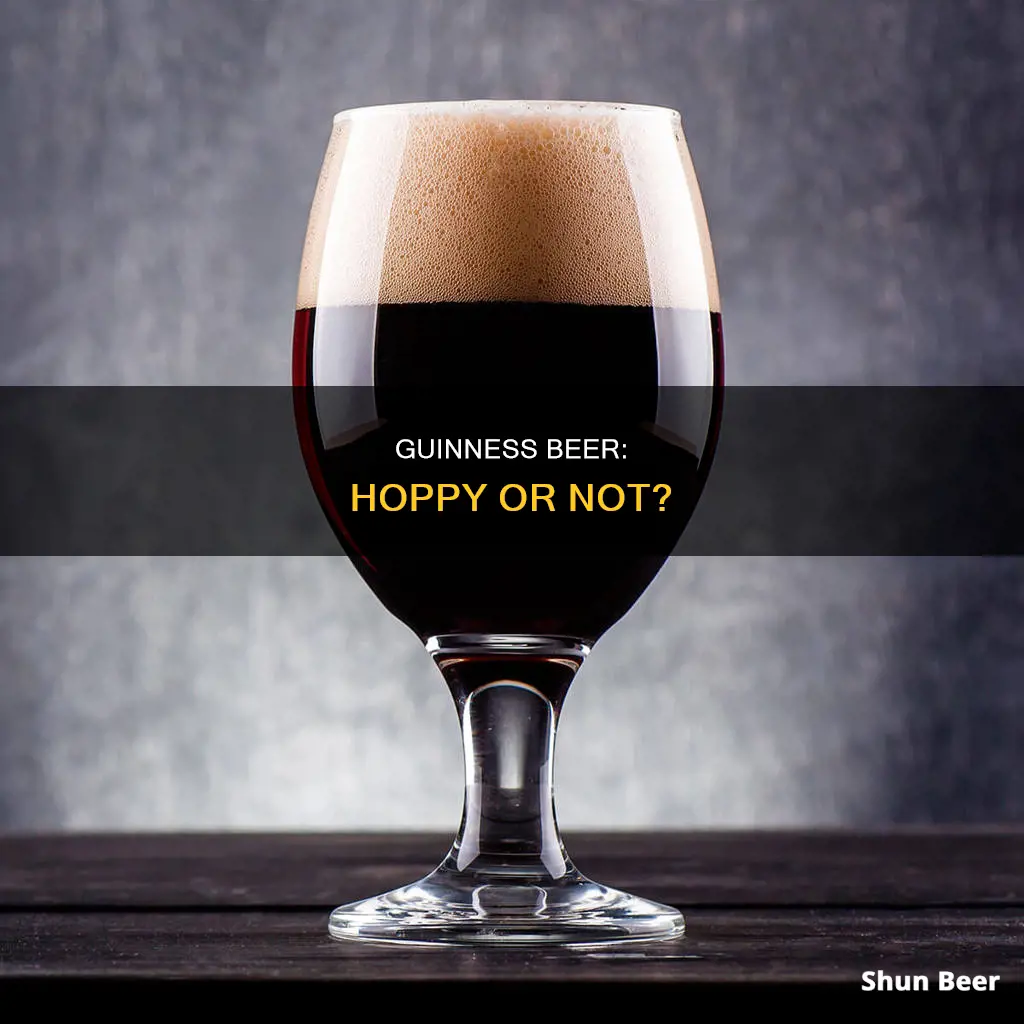
Guinness is a traditional Irish stout beer made from barley, hops, water, and a specific strain of ale yeast. The deep colour and caramelised flavour that are characteristic of Guinness come from barley that has been roasted but not malted. The dark ale is known for its dense, creamy head, which is achieved by mixing the beer with nitrogen to create smaller bubbles that result in a thicker head.
The earliest brewing logs from the Guinness Brewery, dating to the late 1790s, describe “ale”, which at the time referred to a lighter, less hoppy beer. In the early 1800s, Guinness began experimenting with the porter style, which was strong, brown, barrel-aged and vinous.
Today, Guinness Draught is considered to have a malty sweetness and a hoppy bitterness, with notes of coffee and chocolate.
| Characteristics | Values |
|---|---|
| Flavour | Malted barley, roasted unmalted barley, hops |
| Colour | Dark, "officially" a very dark shade of ruby |
| Mouthfeel | Smooth, creamy, balanced, velvety |
| Taste | Malty sweetness, hoppy bitterness, coffee, chocolate, roasted flavour |
| Alcohol by volume | 4.1% to 4.3% (Draught), 7.5% (Foreign Extra Stout) |
| Calories | 125 per pint |
What You'll Learn

Guinness is a stout, not an ale or lager
Stout is a dark brown-to-black beer with hints of chocolate, toffee, and coffee in its flavour. The term "stout" was first used for strong beers in the Egerton Manuscript, a document dating back to 1677.
Guinness, the famous Irish stout, was created by Arthur Guinness in the late 1700s as a variation of porter beer. Porter was first brewed in London in the early 1700s by blending stale beer with fresh, hoppy ales. Arthur Guinness aimed to create a darker, stronger, and "stouter" version of this beer, and thus, stout was born.
Guinness has a malty sweetness and a hoppy bitterness, with notes of coffee and chocolate. It has a smooth, creamy, and balanced palate, often described as velvety. The roasted unmalted barley used in its brewing gives it a distinctive roasted flavour.
Guinness Beer Preservatives in NY: What's the Deal?
You may want to see also

It's made with malted barley and roasted unmalted barley
Guinness is a stout beer that was first brewed in the 18th century at St. James's Gate Brewery in Dublin, Ireland. The flavour of Guinness derives from malted barley and roasted unmalted barley. The use of unmalted barley is a relatively modern addition, with Guinness brewers adding it to the grist in the mid-20th century. The unmalted barley gives Guinness its distinctive roasted flavour.
Malted barley is made from barley grains that have been steeped, germinated, and dried in a kiln. This process activates enzymes in the barley that break down its starches into sugars. The malted barley is then crushed and soaked in warm water to create a sugar solution known as wort. Roasted unmalted barley is added to the wort to give Guinness its dark colour and characteristic taste.
The addition of unmalted barley to Guinness was a significant change to the brewing process. In the early 1800s, Guinness porter was made with rough, smoky brown malt, resulting in an acrid-tasting ale. By ageing this ale in oak vats, the beer transformed into a refined and elegant drink. However, with the introduction of unmalted barley, Guinness was able to create a darker and more robust flavour without the need for lengthy ageing.
Guinness has a malty sweetness and a hoppy bitterness, with notes of coffee and chocolate. The roasted unmalted barley contributes to the beer's roasted flavour, complementing the bitterness of the hops. The combination of malted and unmalted barley gives Guinness its unique taste and has helped make it one of the most successful alcohol brands worldwide.
Guinness Beer's Ball: A Unique Brewing Mystery
You may want to see also

It's got a malty sweetness and a hoppy bitterness
Guinness is a stout beer with a distinctive flavour and taste. Its flavour is derived from malted barley and roasted unmalted barley. The malted barley lends a malty sweetness to the beer, while the roasted unmalted barley gives it a hoppy bitterness. The bitterness is also accentuated by the use of hops in the brewing process.
The malty sweetness of Guinness comes from the malted barley used in its brewing. Malted barley has a sweet, nutty flavour that adds depth and complexity to the beer. It also contributes to the characteristic dark colour of Guinness. The malted barley is carefully roasted to bring out its natural sugars, which gives Guinness its unique malty sweetness.
The hoppy bitterness of Guinness is a result of the combination of roasted unmalted barley and hops. The roasted unmalted barley has a bitter, slightly burnt taste that provides a sharp contrast to the sweetness of the malted barley. Hops are also a bittering agent, adding a distinct bitter flavour to the beer. The variety and amount of hops used in the brewing process can affect the overall bitterness of Guinness.
The interplay between the malty sweetness and hoppy bitterness is what gives Guinness its unique flavour and taste. The malty sweetness provides a smooth, velvety mouthfeel, while the hoppy bitterness adds a sharp, crisp edge. The balance between these two flavours is carefully crafted to create a harmonious and well-rounded beer.
In addition to the malty sweetness and hoppy bitterness, Guinness also has notes of coffee and chocolate, further enhancing its complex flavour profile. The coffee and chocolate notes come from the roasted barley, which imparts a deep, rich flavour to the beer. The combination of these flavours creates a bold and memorable taste experience.
Guinness has a long and storied history, dating back to the 18th century when it was first brewed by Arthur Guinness in Dublin, Ireland. Over the years, it has become one of the most successful beer brands worldwide, enjoyed by drinkers for its unique flavour and taste. The distinct malty sweetness and hoppy bitterness of Guinness have helped establish it as a beloved and iconic beer around the globe.
Guinness Beer and Coffee: What's the Connection?
You may want to see also

It's got a thick, creamy head
Guinness is a beer that is often associated with a thick, creamy head. This distinctively dark beer is characterised by its smooth, velvety texture and unique pouring ritual. The secret behind its creamy head lies in the use of nitrogen instead of carbon dioxide during the pouring process.
A "nitro pour", as it is commonly known, involves using a ratio of 75% nitrogen and 25% carbon dioxide. This combination gives Guinness its signature thick, creamy texture and mouthfeel. The smaller nitrogen bubbles create a less bubbly appearance and a smoother, creamier sensation on the palate. The use of nitrogen also slows down the release of gas from the beer, resulting in a more stable head and a longer-lasting pour.
The ritual of pouring Guinness is an integral part of its appeal. The initial partial pour, followed by a brief wait for the beer to settle, adds to the overall experience. As the creamy top forms and the bubbles rise, the drinker is treated to a visual spectacle that enhances the anticipation of taking that first sip.
The history of Guinness's creamy head dates back to the 1950s when the brewery was facing the challenge of delivering a consistent draft product. The solution came in the form of mathematician Michael Ash, who designed a keg system that utilised nitrogen to create a smooth, creamy texture. This innovation not only solved the "draft problem" but also transformed the beer-drinking experience, making Guinness a beloved classic worldwide.
Today, Guinness continues to be synonymous with a thick, creamy head, and its pouring ritual remains a beloved tradition in pubs and drinking establishments around the globe. The combination of nitrogen pouring, low carbonation, and flaked barley contributes to the distinct texture and mouthfeel that has made Guinness a favourite among beer enthusiasts.
Guinness vs Beer: What Sets Them Apart?
You may want to see also

It's got a low ABV
Guinness is a stout beer with a relatively low ABV compared to other popular beers. The ABV of Guinness varies depending on the specific type of Guinness being consumed, but the standard draught beer, or Guinness Draught, has an ABV of 4.1% to 4.3%. This is lower than the average beer, which typically has an ABV of 5%.
The lower alcohol content of Guinness makes it a smart choice for those looking to take it easy during festive occasions, such as St. Patrick's Day or a night out with friends. With a lower ABV, you can enjoy a few pints without worrying about overindulging. It's a perfect session beer, allowing you to socialise and relax without the risk of getting too intoxicated.
The relatively low ABV of Guinness also contributes to its smooth and creamy mouthfeel. The nitrogen bubbles created by the combination of nitrogen and carbon dioxide used in the brewing process are smaller than those in typical carbonated beers, resulting in a smoother and less fizzy texture. This unique texture, along with its distinctive dark colour and rich flavour, has made Guinness a beloved and iconic beer worldwide.
In addition to its standard draught, Guinness offers a range of beers with varying ABV levels to suit different preferences. For those who prefer a stronger beer, Guinness Foreign Extra Stout has an ABV of 7.5%, while the Extra Stout has an ABV ranging from 4.2% to 5.6%. There is also a lower-alcohol option, Guinness Mid-Strength, with an ABV of 2.8% for those who want to enjoy a beer but prefer an even lighter drink.
So, whether you're toasting with friends or simply enjoying a quiet drink at home, Guinness, with its low ABV, is an excellent choice for a smooth, flavourful, and relatively mild beer experience.
The Bitter Truth About Guinness Beer
You may want to see also
Frequently asked questions
Guinness is a stout beer with a malty sweetness and a hoppy bitterness. The hops create the bitterness in the beer, which balances the natural sweetness that occurs in the beer.
Hops add alpha acids, which we perceive as bitterness on the palate. The hops also play an important role in killing bacteria. Beers with low bitterness will have low IBU (International Bitterness Units).
Beers with low IBU include standard lagers such as Amstel, Stella, and Corona. If you're looking for a non-hoppy ale, stouts and porters (dark beers) are generally sweeter with less bitterness.







